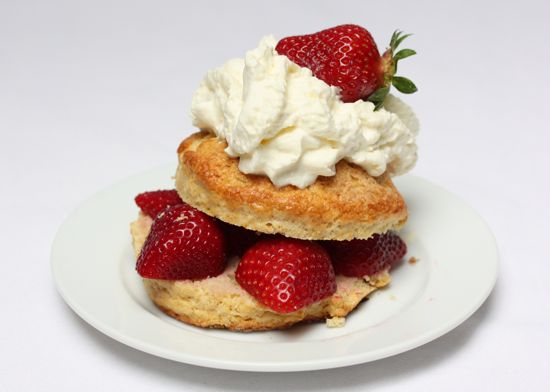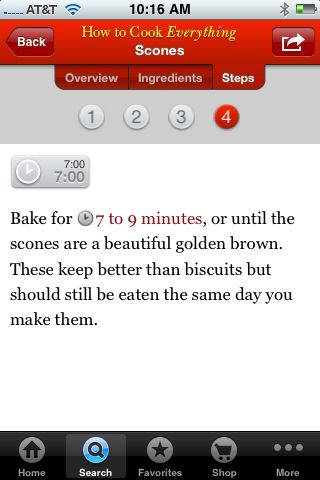
New York Times food columnist Mark Bittman always seems to have his finger on the pulse of how America cooks. His encyclopedic book of pared-down recipes, “How to Cook Everything,” Wiley, 1998, long ago displaced the venerable “Joy of Cooking” as the everyday kitchen reference in our house. My husband would be lost without it.
Now Bittman has joined the smart phone age with his nifty new iPhone app, “How to Cook Everything On the Go” ($4.99). I’m not going to give up my hardback version of his cooking bible anytime soon but I’m smitten with this clever bit of technical wizardry. It has everything in the book and more in a to-go format that is much easier to search.
The shortcake pictured here is based on the simple scone recipe I found while browsing among the strawberry entries. The ingredient list is short, the instructions are simple, and the results are delectable. This may be the easiest, most tender and flaky scone I’ve ever made even though I switched out half of the white flour for whole wheat pastry flour. Use a food processor and the scones are ready to bake before the oven has warmed up.
This portable version of the cookbook, developed by Culinate, is ideal for scoping out dinner possibilities at the grocery store or farmers market. I’m forever buying food that appeals to me in the market only to discover when I get home that I don’t have any idea what I’m going to do with it. With Bittman on my phone, if ribs are on special or baby artichokes are plentiful at the store, I can decide what to do with them on the spot and buy any ingredients I may be missing. Shopping lists are as close as a touch on the screen.
Because the recipes come from Bittman they’re not as much of a gamble as many of those found on anonymous recipe sites. Even Epicurious, one of my favorites, can be hit or miss. But the success rate of Bittman’s dishes is exceptionally high.
All 2,000 recipes are embedded in the application, too, which means you don’t have to use up precious battery power linking to the Internet.
Actually cooking from the app is not quite as appealing. Unlike other iPhone apps that stay on the last page you viewed while you shift back and forth between applications, this one always returns to the home page. You have to keep going back to “recent recipes” under the “favorites” button at the bottom of the screen if you’ve checked your email or the weather in the middle of preparing a dish.
The app also could use photos of the prepared dishes like a number of online sites offer and I’d love it to at least link in appropriate places to some of the videos Bittman has produced for the New York Times web site.
 On the other hand, I’m impressed by the timers embedded in the recipes. Whenever a cooking time is specified, you can click on the highlighted text and a preset timer pops up in the middle of the screen. You can even add minutes if needed.
On the other hand, I’m impressed by the timers embedded in the recipes. Whenever a cooking time is specified, you can click on the highlighted text and a preset timer pops up in the middle of the screen. You can even add minutes if needed.
One downside of using your iPhone in the kitchen, is the danger of getting it all sticky and greasy while you cook. I now enclose mine in a zippered plastic bag while I’m cooking, which works quite well. It’s also good to go into settings and extend the auto lock time so the display isn’t going dark every minute or two.
Now for the scones. These are basically biscuits, enriched with cream and a little sugar, that serve as the shortcake base for freshly sliced and lightly sugared berries. I’ve altered the recipe slightly to add whole wheat pastry flour for extra nutrients and a touch more sugar to balance the flavor.
The shortcakes can be topped with sour cream, yogurt or softly whipped cream. I like to use a nitrogen oxide-charged cream whipper so I can keep any unused cream in the refrigerator for a couple of days. It’s as convenient as an aerosol can but much better tasting since there are no additives beyond cream, sugar, and a flavoring such as vanilla or Grand Marnier.
Bake these scones just before serving. If you want, you can stir them up, cut them out, and freeze them on a baking sheet until solid. Store in a zippered bag in the freezer until baking.
With a little help from Mark Bittman, shortcake is a snap.
Makes 8 3-inch scones
1 cup unbleached all-purpose flour
1 cup whole wheat pastry flour
1 teaspoon salt
4 teaspoons baking powder
3 tablespoons sugar (divided use)
5 tablespoons cold butter
3 eggs
¾ cup cream
Preheat oven to 450 degrees. In the work bowl of a food processor, whirl together the flours, salt, baking powder, and 2 tablespoons of the sugar. Cut the butter into approximately ½ inch chunks and pulse them with the dry ingredients until the mixture just begins to look like very coarse meal. Whisk 2 of the eggs with the cream in a medium bowl until blended. With the motor running, pour the egg and cream mixture into the feed tube of the processor’s work bowl and whirl until the dough comes together in a lightly sticky mass.
Turn dough out onto a floured surface and knead 10 times, adding a little more flour if necessary to handle the dough. It should remain soft and stick a little to your hands. Pat dough into a rectangle, ¾ inch thick, and use a 3-inch cutter or glass to cut into rounds. Although smaller cutters will work, too, the baking time should be shortened a bit. Reshape any leftover dough and cut again. Place rounds on a parchment lined baking sheet.
Beat remaining egg with about 1 tablespoon of water in a small bowl. Brush tops of unbaked scones with egg mixture and sprinkle lightly with remaining sugar. Bake for 8-10 minutes, until golden brown.
If you opt to freeze all or part of the unbaked scones, follow instructions for placing on baking sheet and topping with beaten egg and sugar. Then lower oven temperature to 425 degrees and bake for about 15 minutes.
Scones are best served the day they are baked.
Adapted from “How to Cook Everything on the Go,” by Mark Bittman (Wiley, 2010).
